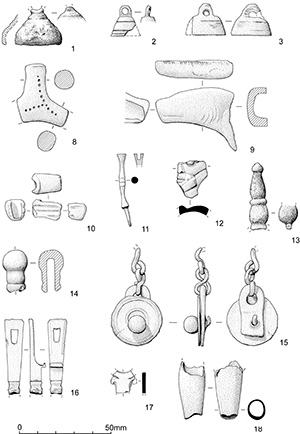
This category contains over two thousand objects, but most of these are unidentifiable fragments. A complete list of all the objects in this category may be found in the archive report. The following list includes those objects that are identifiable but whose function is not clear cut (e.g. bells), and unidentified objects that are potentially identifiable, or of intrinsic interest.
The following are copper alloy unless otherwise specified. The single iron bell has been included with the copper-alloy bells.

Four copper-alloy open bells were found, three of which were unstratified, and described below. The fourth bell was found in the vicinity of the temple, and has been included with the finds of religious significance. Bells were used for a variety of purposes, and most cannot be assigned with confidence to a particular function category.
1. Bell, hemispherical. The suspension loop is broken, and has a slight moulding round the base. There is iron corrosion inside, so it probably had an iron clapper. Poor condition, the surface very bubbly. Ht 20mm, Diam. 25mm. SF1028, Machining layer 4000
2. Bell. A small hemispherical example with a slight flare at the bottom, and a suspension loop. There are three concentric lines on the body. There is no sign of a clapper, although the earth has not been removed from the inside because of its delicate condition. Incomplete and squashed. Ht 17mm, Diam. c. 15mm. SF5344, Machining layer 11000
3. Bell; hemispherical, suspension loop missing, and four incised circumferential lines on the body. It has two opposed circular holes in the sides, and notches on the other two sides, forming two more holes. The notches appear to have been made after casting, as there are saw or file marks visible. There is no sign of a clapper. Diam. 21mm, Ht 17mm. SF4667, Machining layer 11000
This is at first sight a standard Roman hemispherical bell, but with some unusual features that suggest a later date. The circular holes in the sides are atypical for a bell of this shape at any period, although found in closed forms during medieval and post-medieval times. The shape of the suspension loop might have confirmed a post-Roman date, but is missing. The notches cut in the side have no obvious purpose; possibly they were used to suspend the bell after the loop broke.
4. Not illustrated. Fragment from an iron bell with copper-alloy coating. Possibly an animal bell. This is the side of a rectangular truncated pyramidal bell, with a small part of the separate suspension loop. There is a thin coating of copper alloy visible on the lower half of the inside of the bell. The original dimensions (disregarding the loop) would have been W. c. 35-40mm, Depth c. 17mm, Ht c. 32mm. SF2559, Machining layer 11000
Iron bells were frequently coated with copper alloy, and although none is visible on the outside of this example, it may have worn off in antiquity. Bells of this small size were usually made from copper alloy rather than iron, although there are comparable iron bells from Castleford (ht 39mm without the loop; Scott 1998, 134, no. 42) and Vindolanda (ht 44mm without the loop; Jackson 1985b, 147, no. 93). The latter bell is also coated with copper alloy.
5. Not illustrated. Two broken, skewed figure-of-eight chain links, probably interlinked when buried. Made from strips with D-shaped sections. L. 27mm, W. 12mm. SF3450, Spread 10289, Group 820, Area F, Period 4
6. Not illustrated. Chain links; two conjoined skewed figure-of-eight links. The chain is probably too large for jewellery. The links are made from thick wire, Diam. 4mm, L. 16mm, W. 10mm. SF1503, Cleaning layer 8000, Area E, not phased
7. Not illustrated. Two joined figure-of-eight chain links, both incomplete, from a fairly delicate chain, possibly from jewellery. They were made from strips with a section 1x0.5mm; L. of each link 13mm, W. 5mm. SF2358, Machining layer 11000
8. Unidentified object. Y-shaped, with an oval section. Two of the arms are broken; the third is probably complete, and had a line round the bottom, now mostly missing. One face has lines of punched dots in a Y-shape. It is possible that there was further decoration, but little of the surface survives. The purpose of this object and its date is unknown. The decoration is somewhat similar to that on a later Iron Age sword hilt from Wanborough (O'Connell and Bird 1994, 98, no. 4), though the Elms Farm object seems too small to be part of a sword hilt. L. 35mm, W. 27mm, Th. c. 9mm. SF9531, Context 3999, Spoil-heap
9. Fragment from a ?bar. The surface is in poor condition, but has traces of quite elaborate moulding. It is broken at the end across a non-perforating hole. Taking the 'base' as the side with the hole, the base possibly has a shallow collar round the hole, with possible notches or a transverse line. One side has no surviving detail, the other has two shallow longitudinal mouldings. The top has a large notch in the middle of either side. One end may have transverse lines along the bottom. L. 16mm, section 11x12mm. Hole diam. 5mm, depth 9mm. SF8153, Context 3999, Spoil-heap
10. Moulded fragment with a hollow back, possibly part of a vessel mount. The surface is rather irregular, and the top has rather indistinct moulded lines somewhat suggestive of an animal head. The edge has short parallel, oblique marks, probably from the mould. It was broken in antiquity. This may be scrap metal, or a mis-moulding. In fair condition. L. 57mm, max. W. 35mm. SF8142, Context 3999, Spoil-heap
11. A small moulded rod, comprising a symmetrical element with mouldings, flared at the ends, with a narrower point at one end. The other end has a hole in the middle. It somewhat resembles a stylus, but is too small, and lacks the eraser. Dark brown patina, in good condition. L. 40mm, max. diam. 4.5mm, hole depth 3mm. SF8136, Context 3999, Spoil-heap
12. Fragment from the face of a hollow cast figurine or mask, with part of the nose, lips and one eye. Below the lips and on the side of the face, mouldings suggest a heavy beard. Possibly Vulcan? 16x20mm, Th. 4mm. SF9533, Context 3999, Spoil-heap
13. Moulded finial, possibly with a broken ring at the base. The surface is rather concreted. L. 36mm, max. diam. 10mm. SF9534, 3999, Spoil-heap
14. Terminal with a hole for a shaft of unknown material. Broken ring on end, moulded head with blue enamel panels. The surface is in poor condition. It comprises a sub-spherical knob with two narrower cordons below, with the edge damaged. The hole is 5mm in diameter, and penetrates 20mm into the object. L. 23mm, max. D. 13mm. SF8155, 3999, Spoil-heap
15. Pendant fitting, comprising a disc with concentric grooves, fastened by a ball-headed tack through the middle to a tongue-shaped plate. Two figure-of-eight chain links are attached to the other end of the plate. In fair condition. Disc diam. 27mm, hole diam. 4mm, rivet head diam. 9.5mm, back plate 29x14mm. SF927, Machining layer 4000
16. Handle. It has a flat terminal, with a rectangular perforation, tapering slightly to a square-sectioned bar with one face in the same plane as the terminal. There is a scroll on one side only at the junction of the terminal and the bar. The bar has several mouldings, and has the stub of an iron shank set in its end. Possibly a small key handle. The scroll is somewhat reminiscent of an asymmetric hilt guard from a 2nd-century burial at Stansted (Havis and Brooks 2004, 226, H). L. 40mm, max. W. 11mm. SF923, Machining layer 4000
17. Silver. Moulded plate fragment in very good condition. Flat-backed plate with part of a strip with a ?flat ring at one end, and a curlicue on one side at the junction with the plate. The edges are slightly chamfered. Material identified through XRF analysis by Margaret Brooks. SF1083, Machining layer 4000
18. Hollow tube fragment of variable section. This could be a limb from a figurine, as the shape is reminiscent of the calf of a leg. In good condition. L. 32mm, diam. 11-15mm. SF2485, Machining layer 4000

19. Object, edges damaged, probably originally a circular disc, although it could have been tri-lobed. Only a small part of the original edge survives. The surface is in fair condition. It has a central hole with a raised, beaded circle round it, now incomplete. Three groups of small knobs are set round the edge; originally, there were three in each group, though the outer ones are all damaged. Two of the groups are joined to the central ring by two incised lines; the third has no sign of lines. The back is plain, and now slightly irregular, and may have had an incised line round the edge. Possibly a lid? 29x27mm, hole diam. 3mm. SF1227, Machining layer 4000
20. D-shaped loop, with a flat sub-rectangular 'bezel'. The flat of the bezel has a grey surface, possibly solder. XRF analysis by Margaret Brooks showed a significantly higher proportion of lead and tin present on the bezel as compared to the ring. Possibly part of a harness fitting, and possibly post-medieval, although it is the right size to be a back loop from a phalera. However, it lacks the shank normally found on phalerae. In good condition. W. 25mm, Ht 19mm. Bezel 20x14mm. SF5152, Machining layer 5000, Area J
21. Slightly tapering cast tube, with a flange round the wider end. In good condition, but covered in concretion. A similar flanged tube from Segontium (Allason-Jones 1993, 174, no. 101) is described as a possible trumpet mouthpiece, but this interpretation appears very unlikely, as the mouthpieces of brass instruments are normally cupped. Margaret Brooks notes that this object appears to have been burnt. L. 64mm, Diam. 13-18mm, Diam. of hole 6-12mm; Diam. of flange 29mm, Th. of flange 5mm. SF2070, Fill 5399, Pit 5400, Group 454, centre of Building 63, Area J, Period 6
22. Strip bent into a ferrule or strap slide. One end is broken at the start of the bend. It has a moulded herringbone band down the centre, with a groove either side, and possible organic material on the inner face. It was found with strip fragment SF4754, the broader end of which is the same width as this strip, but the two are probably not connected, as SF4754 is plain. The surface is rather bubbly. 19x3mm, W. 14mm. SF4745, Layer 5907, Group 601, Area I, Period 3B
23. Distorted rod fragment with a square moulding in the middle. One end is pointed, with a round section. The other end has a groove down one side. The moulding is sharp on two faces, and flattened on the other, suggesting that this might be a mis-casting. The object appears complete as buried. Possibly part of a toilet implement. L. 48mm. SF7360, Fill 6963, Pit 6964, Group 70, Area H, Period 2B
24. H-shaped object, probably a fastener. One arm is slightly longer than the other, and has a small disc at each end. In fairly poor condition, with a patchy surface. The writer noted similar fasteners (though slightly larger) in the Archaeological Museum in Barcelona, of Iron Age date. L. 20mm, W. 19.5mm. SF6043, Fill 8270, Pit 8269, Group 790, Area E, Period 3
25. Strip, with one end bent at right-angles, and the other broadening into a ? fish-tail-shaped terminal, with one fluke missing. Possibly part of a small vessel handle. In fair condition, surface partly obscured by earth. L. 42mm. SF7374, Fill 8990, Well 8989, Group 662, Period 3-4
26. Cast fragment. Curved, with a roughly triangular section with a moulding round the outer edge. Possibly part of an armlet or terret. L. 24mm, W. 9mm, Th. 4.5mm. SF4928, Fill 9704, Pit 9792, Group 288, Area D, Period 2B
27. Curved bar with a slot down the back, set off centre, and a ball terminal. The other end was broken in antiquity, and the surface of the object is very rough and fissured. Possibly a mis-cast object, possibly part of a furniture fitting. L. 58mm. SF7489, Machining layer 11000
28. Copper-alloy terminal; ring-headed, with a tubular, split socket. It had two, or possibly three incised lines round the end of the socket, partly obscured by iron corrosion. The shaft was probably iron. In good condition, with slight damage to the surface. Possibly post-Roman. L. 35mm, socket external diam. 6mm; ring external diam. 21mm, internal diam. 11mm. SF6081, Machining layer 11000
29. Unidentified cast fitting; the terminal is a three-dimensional 'duck's-head' shape, with a sub-rectangular transverse slot, possibly cracked across the top, although this may be a casting flaw. The base is flat. The thicker end of the terminal has a fragment of a sharply curved plate, perhaps part of a socket, the edges broken in antiquity, but possibly with the full height surviving. Possibly post-Roman. L. 42mm, max W. 16mm, max. Th. 14mm, slot 8x4mm. SF5306, Machining layer 11000
30. Fitting, complete as buried, but with a corner missing. It comprises a tube with a slightly faceted D-shaped section, with the curved part cut away for part of its length. This end has a shallow notch in the middle of its outer face. L. 27mm, section 13x10mm. In good condition, possibly post-Roman. SF3715, Machining layer 11000
31. Terminal; acorn-shaped, with moulded vertical lines. There are two small, opposed holes near the base. There is a hole in the centre, diam. 6mm and c. 19mm deep. The alloy is probably a leaded bronze. Surface in fair condition. Ht 21mm, max. diam. 15mm. SF5324, Machining layer 11000
32. Part of a sheet disc, probably originally oval, slightly concave. It possibly had a projection at the end, although this is now damaged. It has shallow moulded lines round the edge, and a linear design in the middle. The back has traces of solder. There may have been a central hole, diam. c. 2mm. W. 15mm, surviving L. 12mm. SF2938, Machining layer 11000
33. Sheet, folded into three layers to form a ?strap-end. Two of the layers are riveted together by three copper-alloy rivets. The top layer has an incised pattern, rather difficult to make out as the surface is in fairly poor condition, and notches along the edge. The edges are broken, but the position of the notches suggests that almost the full width is present. 25x14x5mm. SF5685, Machining layer 11000
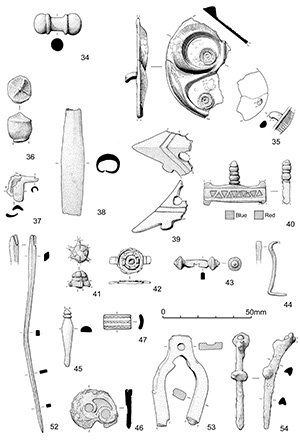
34. Dumb-bell toggle. In fair condition, with some damage to the surface. L. 26.5mm, head diam. 12mm. SF5421, Machining layer 11000
This is a well-known type that can be made from either bone or copper alloy, and occurs in both Late Iron Age and Roman contexts. Some are flat backed, others modelled in the round, as is this example. Their distribution is principally in northern Britain, and mainly from military sites. There is a very similar example from Dragonby (Knowles and May 1996, 273, no. 34). Their purpose is obscure; a bone example from an Arras burial tradition grave at Acklam was probably from the area of the lower right leg, and possibly associated with the sword from the burial, leading to the conjecture that it was attached to the harness supporting the scabbard (Dent 1983).
35. Plaque fragment in two joining pieces, with moulded decoration and one integral rivet on the flat back. It has a curved edge, and may have been circular. There are two cells present; one is circular, containing a moulded motif of three concentric circles, the middle one beaded; the other is incomplete, but not circular, with a similar motif in poor condition. The frame has vertical ribbing on the edge. The ribbed lines and use of crescent rings echoes the decoration of an Iron Age horse brooch, found by a metal detectorist in Bocking, Essex (Sealey 1991, 1). The latter piece has affinities with a brooch from the Polden Hill Hoard, and is likely to be of south-west British origin. The Elms Farm piece, which is more three-dimensional, and not enamelled, is not directly comparable to the Bocking horse brooch, but may also be from horse furniture, and could be of similar date, that is, the first half of the 1st century AD. Diam. 64mm. SF7193, Machining layer 11000
36. Moulded decorative terminal, in very poor condition, surface very unstable. It is a slightly asymmetric cup-shape, with a low conical top. There is a moulded line round the edge, and four radial ribs with a central nipple. Only the stub of the broken rectangular shank is present. Possibly post-Roman. Diam. 15mm, Ht 17.5mm. SF6503, Machining layer 12000, Area R
37. Edge binding? Small fragment of sheet bent into a U-shape, with a lug either side. Broken at both ends. The lugs have a convex surface, rather than being flat. 15x14mm. SF5530, Fill 14226, Pit 14225, Group 36, Area L, Period 2A-B
38. Spindle-shaped sleeve, made from sheet metal. The length appears complete. This may have been an unbroken tube, although one side was damaged and split along the whole length in antiquity. In fairly good condition. L. 60mm, max. diam. 13.5mm, min. diam. 10mm. SF5556, Cleaning layer 14484, Area L, not dated
39. Cast plate fragment. It has a V-shaped, obtuse-angled, cross-section. It is roughly V-shaped, with the wider end broken across a hole either side. One edge has a rounded lug. The front has two incised chevrons. Date uncertain. In good condition. L. 40mm, W, 27mmm, Th. 2mm, hole diam. 7mm. SF7155, Machining layer 17150
40. A rectangular plaque with row of enamelled triangles, alternately light blue and an unknown colour (only the blue enamel survives), flanked by grooves. In the centre of one long side is a short beaded rod, the end of which is broken. Alternate beads have incised transverse lines, surviving only in places. At each corner of the long sides is a short projection. Three of these are definitely incomplete, but the fourth may be complete. The back of the panel is rather irregular. W. 35mm, L. 25mm, Th. 4mm. SF7143, Machining layer 17150
The original shape of the object is unknown, as all the projecting parts are damaged. It was possibly a chatelaine, although enamelled examples are rare, and more usually chatelaine brooches (which this is not). Hattatt (1987, 196, fig. 62a) illustrates a chatelaine brooch with enamelled triangles and lozenges. An elaborate enamelled chatelaine proper from Castleford (Cool and Philo 1998, 86, no. 363) is somewhat different in its decoration.
41. Fitting, in poor condition. It has a central boss, probably with six moulded lobes, very corroded and poorly defined, and a raised band round the base. The top of the boss is damaged, and there may have been further elements. There are six broken projections set round the base. The back has a broken shank with a circular section. The top and back have patches of gold foil. XRF analysis by Margaret Brooks showed this to be gilded bronze (copper/lead/tin). Possibly medieval. Surviving diam. c. 15mm, Ht 9mm. SF7156, Machining layer 17150
42. Disc, with two opposed rectangular projections, each with a transverse groove, and probably incomplete. The disc has crisply moulded detail, comprising a segmented circle with a central cupped ring. The edge is nicked, and the back fairly flat. In good condition. There is an almost identical piece from West Stow, from the blown sand layer sealing the Saxon occupation (S.E. West 1985, 60 and fig. 238.15). The latter object is complete, with the disc set in the middle of a short strip, the ends of which are split, and pierced by tiny iron rivets. The disc has traces of enamel. It is listed under 'bracelets', and dated as 'Roman', although no parallels are cited, and the object is only very slightly curved. Diam. of disc 15mm, L. 24mm. SF7153, Machining layer 17150
43. Small rectangular-sectioned bar with a W-shaped notch in the middle, and bi-conical terminals, decorated with radial lines on the upper surface. Each terminal has a plain end cap. This resembles the crossbar of a small crossbow brooch, but appears to be complete. The surface has flaked in places. L. 26mm. SF7929, Fill 24198, Pit 24197, Group 696, Area M, Period 4
44. Rod, pointed at one end, with a right-angled bend near this end, and the other end flattened and curved over. Possibly a small hook or catch; the flattened end may have originally been a suspension loop, and the right-angled bend looks quite deliberate, as the rod is slightly crimped at this point. One side has two transverse lines below the loop, possible tooling marks rather than decoration. L. 30mm. SF8078, Fill 24398, Well 22210, Group 448, Area J, Period 6
45. A rod fragment with a D-shaped section and mouldings at either end. Both ends are broken. This could possibly be part of a pendant from a military belt, but is too incomplete to be certain. L. 34mm. SF2248, Ditch 10290, Group 642, Area F, Period 5
46. Enamelled plaque. It was probably oval originally, but it is difficult to identify the original edges; the metal is pustular, and in very poor condition. It has curvilinear panels of red enamel, the colour only partly surviving. There are possible parallels with a decorative plate from Billericay, Essex, which has a similar curvilinear design, and possible traces of red enamel (Major 1990, 41, no. 12). The latter piece is from a 4th-century well fill, but is presumably residual. 28x23x4mm. SF53, Machining layer 3830, trench 5
47. Strip fragment with three sunken channels, each containing a raised zigzag, between mouldings. Slightly convex in section. Possibly part of a brooch bow, though it has no longitudinal curve, nor does it appear to have been flattened. Moreover, it is very narrow for a brooch, of unusual thickness, the ends appear to have been neatly cut, and there is no real sign of corrosion (this object is also noted in the brooch report, no. 214). L. 16mm, W. 8mm. SF6986, Unknown context 11367, Area N, not phased
48. Not illustrated. A pear-shaped iron object of constant thickness, with a central hole. Complete as buried, but probably part of a larger object, broken in antiquity. An irregular piece of copper-alloy sheet has been partly wrapped round the iron. Margaret Brooks notes that this appears to have been burnt, and that there are tiny drops of melted crystalline lead on the surface of the iron. The iron object and the sheet are probably both scrap metal, and not necessarily originally connected. Iron object 24x20mm, Th. 9mm, hole diam. c. 5mm; copper alloy sheet c. 34x29mm. SF2070, Fill 5399, Pit 5400, Group 454, Period 6
49. Not illustrated. Curved rod fragment, with a flattened terminal, broken at both ends. There is a low moulding with two transverse lines at the junction of the shaft and terminal. This is possibly part of a toilet spoon, but there is so little of the object surviving that it is difficult to be certain. L. 12mm, wire diam. 2mm. SF7438, Fill 8597, Pit 8594, Group 222, Area P, Period 2
50. Not illustrated. A thin, cast fragment, of variable thickness, with an irregularly convex surface. All edges are broken. Margaret Brooks notes that the surface has a high tin appearance, and that the surface has numerous small marks, some obviously damage, but others probably due to tooling of some sort rather than decoration. The shape suggests that this might have been part of a figurine. c. 24x10mm. SF6936, Machining layer 11000
51. Not illustrated. Bar, with the surface flaked at both ends, but probably complete. It has a variable rectangular section, and tapers towards either end. One end is pointed, the other has a blunt chisel point. One face has a slightly raised, stepped section in the middle. L. 38mm, max. sect. 8x5mm. It is possibly a small awl, though these more typically have a circular or polygonal section at one end. It would be very unusual for a Roman awl to be made from copper alloy, and it is possible that this is a residual piece, possibly Bronze Age, such as is proposed for three bronze awls found on the Roman site at Baldock (Needham 1986). L. 38mm, max. section 8x5mm. SF4690, Machining layer 11000
52. Bent bar with a variable rectangular section. One end is pointed, and the other has a blunt point, crudely bifurcated. Possibly an unfinished object. L. 114mm, max. section 4.5x3mm. SF7849, Fill 23135, Pit 23158, Group 31, Area N, Period 2
53. Bifurcated bar, with a non-perforating hole at the junction. The ends of the slightly curved arms are probably broken; the other end appears complete. The inner edges of the tines have a complex curve adjacent to the junction. In fair condition, surface partly flaked. This is possibly post-medieval. L. 52mm, W. 32mm. SF1843, Machining layer 4000
54. A slightly curved bar, with a groove underneath, two adjoining knobs on top, and a circular terminal with the remains of a rivet through it. Possibly a handle. L. 57mm. SF3286, Layer 9426, Group 1301, Area D, not dated
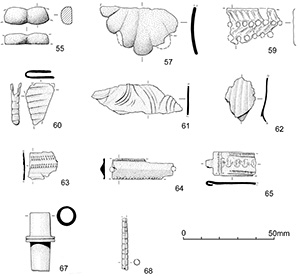
55. Bar fragment with two barrel-shaped segments, flat-backed. The back is fairly uneven. There is no original surface left, and both ends were probably broken in antiquity. The bar is slightly curved in the plane of the back, suggesting that this was part of a larger ring of beaded elements. If the curve were at right-angles to the back, then this could be seen as part of a beaded armlet, but as this is not the case, a different identification must be sought, such as part of a decorative mount. 25x10x7mm. SF1311, Fill 5162, Pit 5180, Group 443, Area J, Period 6
56. Not illustrated. A delicate curved and twisted bar, flattened and broken at one end, the other end broken in antiquity. In very good condition, with a dark patina. It is possibly a bracelet fragment, although the flattened end is not typical of cable bracelets, and the curve is possibly not original. It is from a possible structured deposit. L. 32mm, max. diam. 2mm. SF7969, Fill 22051, Well 22210, Group 448, Area J, Period 6
57. Plate fragment, roughly semi-circular, with incised lines against a scalloped edge. The straight edge was broken in antiquity, and the back is rather rough. There is both ancient and modern damage to the scalloped edge. 45x37mm. SF5310, Machining context 11000
58. Not illustrated. Ring with a rib round the circumference, in three pieces. The condition of the surface is partly good, and partly poor. This effect may have been caused by contact with another material, possibly an attached strap, during burial. Probably either a box fitting, or from harness. External diam. 32mm, internal diam. 21mm, Th. 4.5mm. SF120, Fill 2311, Ditch 2312, Group 892, Area W, Period 4-5
59. Sheet fragment with an embossed herringbone pattern and cut-out holes. One original straight edge. Possibly from a religious plaque. In good condition, but holey. L. 30mm, W. 21mm. SF303, Machining layer 4000
60. Thick triangular sheet, folded in half, and decorated with parallel grooves. There are possibly traces of white metal coating. In fair condition, corners damaged. Th. 1.5mm, 16x22mm. Possible votive? SF942, Machining layer 4000.
61. Sheet fragment, roughly leaf-shaped, but with all edges broken. It is slightly undulating, though this may not be original. It has linear decoration, partly outlining very low relief ridges. This is presumably part of a larger plaque, whose subject matter is obscure. 51x17mm. SF5617, Machining layer 11000
62. Sheet fragment with moulded ribbing on one side. Possibly part of a statuette. All edges broken. c. 24x17. SF3716, Machining layer 11000
63. Sheet fragment, no original edges. Decorated with parallel slightly raised bands, two of which have imitation couching, probably punched. One is either worn or poorly impressed. 16x15mm. SF7822, Fill 24198, Pit 24197, Group 696, Area M, Period 4
64. Cast strip with triangular section and cabling along the edges. Broken across a small hole at each end. In good condition. 39x12mm, Th. 2.5mm, hole diam. 1.5mm. SF8140, Context 3999, Spoil-heap.
65. A sheet strip, broken at one end, and with a single central tab at the other, bent over to form a hinge or suspension loop. It is decorated, with grooves with short transverse lines below the loop and along the edges. There is a row of curvilinear motifs down the middle, which appear to be punched rather than incised, as each has a shallow transverse depression placed identically. 27x13mm. SF3584, Machining layer 11000
66. Not illustrated. Two joining fragments of a sheet strip with embossed dots along each edge. One end is squared, and original; the other is incomplete. There is one rivet hole in the middle of the complete end. In fair condition, but slightly crumpled. 58x15mm, hole diam. 2mm. The surface shows a series of longitudinal, parallel fine lines, probably polishing marks. SF5439, Fill 14022, Pit 14098, Group 4019, Area K, Period 4-5
67. Tube, with a central flange, the edge of which has a groove. In good condition. This is presumably for joining two pieces of tubing. It is not necessarily Roman, but could be. The tube tapers slightly, from 11.5-10mm diam., with an internal bore of 1-5.5mm. L. 33mm, diam. of flange 16mm. SF670, Machining layer 4000
68. Tube, broken at one end, formed from a strip whose edges butt or overlap slightly. It has circumferential lines. L. 28mm, diam. 3.5mm. SF7669, Layer 21620, Group 446, Area J, Period 6
69. Not illustrated. Fragment of thick wire, with a variable section. It is bent into a teardrop-shaped loop, with one end broken, and the other formed into two coils. These would presumably have been wrapped round the broken end of the wire. The top of the loop has a square section, becoming circular towards the ends. This is probably a suspension loop, possibly from a steelyard, although lacking the typical keyhole shape. L. 28mm, W. of loop 13mm. SF1953, Cleaning layer 4757, Area K, not phased
70. Not illustrated. Thin wire, tapering at one end and with an irregular curve. Both ends are broken. A thin strip, probably broken, has been wound round the wire, forming just over one coil. This was possibly part of an expanding wire bracelet, although these were usually made from thicker wire. However, there is another wire fragment of similar thickness from elsewhere on the site (SF5149), which is probably from jewellery as it has silver wire wound round it. L. 42mm, diam. 1.5mm. SF1306, Layer 5275, Group 457, Area J, Period 5-6
71. Not illustrated. Wire, looped over and twisted round itself. This is probably a distorted suspension loop, either from a toilet implement (see Crummy 1983, 62 no. 1943, for the type, which is late C3-C4 at Colchester), or a steelyard hook (as, for example, Allason-Jones 1993, 172, no. 82). In poor condition. L. 31mm. SF7771, Prepared surface 21789, Group 375, Area J, Period 3
Bar fragments. In total, 185 bar fragments were noted, most of which had no significant features. Some are likely to be stock or waste from iron-working, others tangs from tools.
Chains There were oval and figure-of-eight chain links from ten contexts. In three cases several links survived, all parts of chains composed of more than one type of link. The chain from cleaning layer 6515 (not phased) was composed of oval and circular links, while that from pit 10067 (Period 5) was made from oval and figure-of-eight links. The third chain fragment (pit 11437, Period 2) was made from quite delicate oval and circular links, and may have been from a decorative chain.
Bell. An iron bell fragment has been included with the copper-alloy bells.
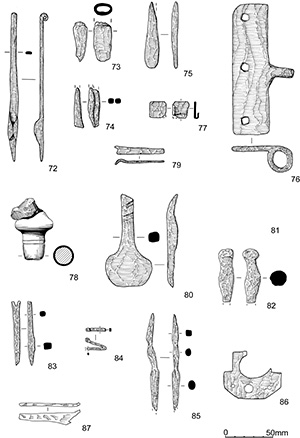
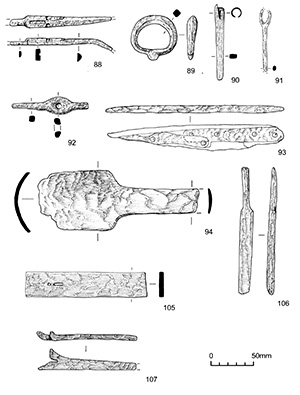
72. Object in three joining pieces. A narrow rectangular sectioned strip with one end formed into a small loop. The other end is pointed. Just above the point, two flat wings on either side have been bent over to form a socket. L. 146mm, strip section 6x4mm. Fill 10597, Pit 10552, Group 299, Area F, Period 2B
73. Socketed, wedge-shaped object. It has an irregular, rounded section, with a slightly bevelled point. The other end is incomplete, broken in antiquity. This end has a ledge round the outside, as if something was seated round it; perhaps a separate metal band, or part of the handle. The socket is oval. This object is reminiscent of Rees' Type 1b ard shares, though it is much smaller (Rees 1979, 50ff). Possibly it was a shoe from a small digging tool. L. 42mm, max. section 19.5x15mm. Fill 13061, Post-hole 13131, Group 610, Area I, Period 3B
74. Two bar fragments with flattened tips, corroded together. Possibly the tips from a small pair of pincers. They seem to be fairly crudely finished. L. 40mm, max. section 7x5.5mm, tip W. 10mm. Machining layer 12000, Area R
75. Tool?. Flat spatulate head with a rounded end, narrowing to a broken 'tang' thicker than the head. L. 69mm, head W. 14mm, tang section 9x5mm. SF5453, Fill 14204, Foundation pit 14203, Group 720, Period 6
76. Rectangular plate with three rectangular perforations, set symmetrically. A looped projection is set at an angle in the middle of one edge. The plate is quite sturdy, the loop less so. Possibly a hinge plate, although the loop looks too insubstantial for this, compared to the robustness of the plate. 138x36x6mm, hole W. c. 7mm, loop external diam. c. 20mm, internal diam. c. 11mm. SF1288, Fill 5214, Pit 5209, Group 442, Area J, Period 6
77. Object, complete as buried. A roughly square sheet, with two edges folded over, possibly over an iron wire. There are traces of copper-alloy corrosion along the edge, possibly plating. This may be a protective binding for a corner, resembling modern book corners. 16x18mm. SF1638, Layer 6121, Group 556, Area H, Period 4
78. Iron rod with a mushroom-shaped terminal with a central knob, probably complete. The knob has split off, probably due to the corrosion of the iron, and there is a lump of iron concretion masking part of the top. Apart from this, it is in good condition. The object is plated with copper alloy. The rod has two circumferential lines. This is presumably part of a larger object, broken in antiquity. Copper-alloy plating of iron is not a common Roman technique, but occurs particularly on Late Iron Age horse bits. This object is not, however, part of a bit bar; the terminal could be seen as the roll from a bit bar, but is not symmetrical, which such rolls always are. Whatever this is from, a Late Iron Age or post-medieval date seems most likely. Diam. of rod 11.5mm, diam. of head 20mm, Ht 32mm. SF7171, Machining layer 11000
79. Small strip, tapering slightly to a squared end. The other end has a squared notch in it, and is probably broken. Possible a buckle plate, especially since the notched end is slightly curved, as if to take the cross bar of a buckle. However, the strip is unperforated, with no visible means of attachment, and would be unusually delicate for a Roman buckle plate. Alternatively, it could be a buckle tongue, although this would not account for the notch. It is possibly an unfinished object. L. 51mm, W. 5-9mm. SF1873, Layer 5275, Group 457, Area J, Period 5-6
80. Object resembling a chisel with a sub-circular blade. The surface is in good condition. It has a rather thick splayed 'blade', slightly concave, with a bevelled edge and a short shank with a rectangular section. The end has transverse marks, probably hammer marks. This may be an unfinished object. L. 96mm, max. W. 46mm. SF2379, Fill 6367, Well 6280, Group 531, Area H, Period 3-4
81. Ferrule? Square-sectioned socket with flat end. It probably had a small flange round the open end, now rather damaged. Not certainly complete. There are possible traces of wood in the socket. Ht 18mm, W. 13mm. SF1535, Unknown context 9056
82. Bar, with a bulbous head, and a variable asymmetric section. The other end was broken in antiquity. The surface is in poor condition, and the head was damaged in antiquity. This is possibly part of a tool such as a punch. L. 57mm, max. section 17x16mm, head diam. 17.5mm. Fill 17062, Post-hole 17064, Group 949, Area Q, not dated
83. A bar with a variable oval to rectangular section. One end is notched, forming two short prongs. The shank expands slightly before tapering to a probable chisel point. This end is probably nearly complete, though it has flaked slightly. L. 67mm, max. section W. 7.5mm. Fill 4152, Pit 4137, Group 756, Area K, Period 3
84. Small V-shaped bar of variable section, tapering slightly to the broken tip. The section appears to change from rectangular to circular near the tip. The other end is formed into a neat loop. It is uncertain whether the object was originally straight; there are no signs of stress to the metal on the X-ray. It could be part of a toilet implement, although these are extremely rare in iron. It was originally thought to be part of a brooch foot (there is an iron brooch head from the context), on the evidence of the X-ray, but the looped end rules out this interpretation. L. 24mm, loop W. 4mm, max. section 4x2mm. Layer 4540, Group 1163, Area K, not dated
85. Rod, with a variable section. It is in three sections, with a slight change of angle between each. One end has a square section, and is pointed. The centre has an oval section, with a slight constriction at each end. The other end is conical, with the tip missing. It is possibly a tool of some sort. L. 113mm, max. section W. 9mm. Fill 24003, Pit 24004, Group 712, Area M, Period 5
86. Plate, cut into a complex shape. One end is half a hexagon, with a central hole punched through, diam. 10mm, and two smaller holes in the corners, diam. 4mm. The other edge of the plate is partly missing, and now bent, but if originally symmetrical it would have been rectangular, narrower than the hexagon, with a large central hole, diam. 31mm. It is in good condition, and Vanessa Fell (Institute of Archaeology, Oxford) suggests that it may be modern. If it is contemporary with its context, and not a modern contaminant, then it could be some sort of box fitting. W. 61mm, L. 47mm. SF5549, Layer 14389, Group 2042, Area L, Period 2B
87. Tapering bar of constant thickness. One end probably comes to a point; the other apparently bifurcates, with one branch tapering into a small knob, and the other branch probably broken. It somewhat resembles the spike at the bottom of a candle-holder such as Manning 1985a, P1, but is more delicate, with the broken branch half the maximum width of the bar. L. 64mm, max. W. 11mm, Th. 3mm. SF6923, Fill 8802, Pit 8801, Group 678, Period 6
88. Unidentified object. A tapering bar of variable section, both ends broken. The back is flat throughout. One end has a thinner, narrow bar set in line with the back. The adjacent half of the object has a rectangular section with a shallow, stamped rectangle in the middle, notches either side, and a shallow V or U-shaped notch in the middle at the junction with the other half of the object. The lower part has a D-shaped section, with the last 22mm sloped down at an oblique angle. L. 119mm, thin bar 15x7x2mm; section of rectangular part 14x6mm; section of D-shaped part 10.5x5.5mm - 5x4mm. SF5814, Fill 10922, Pit 10953, Group 673, Area N, Period 4
89. D-shaped loop, with a diamond-shaped section of variable thickness. The straight side has a small rectangular projection, probably incomplete, and integral with the loop. The surface is flaking. The object resembles a buckle, but the integral projection suggests that it is not a buckle. It could be part of a strap junction, possibly with loops either end of a bar (cf. Unz and Deschler-Erb 1997, Taf. 67, no. 1930). Alternatively this might be a terret (although these are normally made from copper alloy). W. 55mm, L. 51mm, max. section 12x10mm. SF6976, Fill 11302, Pit 11303, Group 671, Area N, Period 5
90. Socketed bar, the socket broken in antiquity. The bar has a square section and a blunt point, which appears complete. It may be a ferrule, or a socketed punch. L. 89mm, max. diam. 12mm. Cleaning layer 20000, Area L, not phased
91. Netting needle? Circular-sectioned rod with two broken prongs at one end, other end broken. This could possibly be just a loop-headed bar. L. 75mm, rod diam. 5mm, W. across prongs 14mm. SF7569, Cleaning layer 20184, Area L, not phased.
92. Object, complete as buried. It comprises a rectangular-sectioned bar, broadening off-centre into an oval plate. A round hole has been punched through the oval, dishing it slightly. In poor condition, flaking. L. 90mm, max. W. 22mm, bar section 7x7mm. Fill 5375, Ditch 5359, Group 443, Area J, Period 6
93. Unidentified flat object, L 205mm. There is a double thickness of metal present, with a piece of sheet up to 32mm wide extending the whole length of the object. The back is straight, and thickened. One end is curved, the other damaged and possibly incomplete. One edge is damaged, and very faint on the X-ray. It possibly has a sharp edge. On one face of the sheet, are two narrower strips, overlapping in the middle. The first strip lies along the back of the object, and has rounded ends. There are four perforations, unevenly spaced. The second strip lies over the first, and angles out slightly from the broken end. The end in the middle of the object is probably rounded, but the inner edge tapers towards the broken end. There are two perforations. It is unclear whether the back is integral with the sheet, or whether the various parts are actually riveted together. Possibly modern. L. of first strip 117mm, W. 13mm; L of second strip 105mm, max. W. 13mm. SF1435, Machining layer 4000
94. Unidentified object. It consists of a flat strip of constant width, and a thin D-shaped section, with slight damage to the end but probably almost complete as buried. The other end widens into a rectangular sheet, shallowly curved across the width. The length is probably complete as buried, though this part is now in several pieces (some missing) owing to recent damage. This is unlikely to be a modern intrusion, as it has a Roman pot rim corroded on. L. 190mm, strip 92x28x4mm, 'blade' W. 70mm. SF5140, Cleaning layer 5597, Area I, not phased
95. Not illustrated. Very small sheet eyelet. External diam 15mm. SF8244, Layer 4699, Group 2027, Area K, Period 2
96. Not illustrated. Object, in very poor condition. The centre of the object is a thin, roughly rectangular plate, with two 'tangs' springing from one of the longer sides, forming a non-symmetrical, very shallow V-shape. The ends of both 'tangs' are broken, though one appears to be coming to a point. This is possibly just working waste, not an object as such. L. 92mm, central plate c. 18x14mm. Fill 3596, Pit 3597, Group 889, Area W, Period 3
97. Not illustrated. Fragment from an unidentified object, comprising a curved bar fragment with a rectangular section, one end broken in antiquity. A plate is integral with, or attached to the underside of the curve at the other end. This end has fresh breaks. It is unclear whether the plate extended on both sides of the bar. This could be part of a handle, or part of an object such as a large padlock. L. 65mm, section 14x9mm. SF1547, Fill 9064, Pit 9029, Group 783, Area D, Period 3
98. Not illustrated. Blade-like object, with a centrally set 'tang', the end of which has a fresh break. The 'blade' has rounded shoulders and is parallel-sided, with a straight end which is very thin, damaged, and possibly incomplete. The sides do not appear to be edged. The 'tang' has a D-shaped section, more typical of box fittings than blades, and it is likely that this is some sort of fitting rather than a blade. L. 56mm, 'tang' section 9x5mm, 'blade' W. 30mm, L. 35mm. SF5841, Layer 13445, Group 600, Area I, Period 3
99. Not illustrated. Sub-spherical lump, possibly a weight or a plumb bob. Diam. c. 30mm. SF6632, Fill 15463, Posthole 15466, Group 688, Area M, Period 3
100. Not illustrated. Irregular lump, possibly the butt of a hammer or small axe, with part of the curved edge of the socket present. W. 38mm, L. 34mm. SF2334, Layer 6253, Group 4008, Period 4
101. Not illustrated. Object resembling a very small stemmed anvil, with the stem broken. The head is roughly rectangular, with some damage. The X-ray shows the edge of the 'head' as irregular and fissured, and this is probably just scrap metal. It could possibly be a vessel foot, but the bottom is quite rounded, making this interpretation unlikely. Head c. 40x24mm, L. 33mm. SF4291 Layer 4689, Group 4019, Area K, Period 4-5
102. Not illustrated. Unidentified object, possibly scrap metal. It resembles a tanged blade, with a straight back, and a bolster between the tang and blade. The 'blade' is slightly dished and has no edge. It has been cut transversely close to the bolster, the cut being slightly bevelled. The bolster is almost the same thickness as the tang, which is bent at a slight angle. It seems unlikely that this is a gouge or chisel, as the blade is set asymmetrically. L. 68mm, W. of 'blade' 24mm, 'bolster' section 13x6mm, tang section 5x4mm. Layer 5502, Group 646, Area I, Period 6
103. Not illustrated. Object, consisting of a curved rod with a circular section, broken at one end. The other end is bent at c. 135°, and is flattened into a truncated leaf-shaped plate. This plate appears to be complete, but may have been cut. This may be an incomplete and distorted latch-lifter (which seems most likely), or, if the flat end is complete, it could be some sort of tool. L. 230mm, plate 32x21mm. SF6247, Cleaning layer 14503, Area L, not phased
104. Not illustrated. Cylinder, possibly a weight. Diam. 30mm, Ht 24mm. SF6404, Cleaning layer 15024, Area M, not phased
105. Bar, probably complete, in fair condition. One side is slightly rounded, the other flat. It has two perforations set along the central line. One is a small square hole 26mm from the end, W. 3mm; the other is a longitudinal slit 4mm away from the hole, measuring 11x2mm. The purpose of these holes is unknown; they do not seem large enough to be nail-holes. The bar itself is quite thick, and it is unlikely to be a piece of strapping. 143x26x8mm. SF1814, Layer 5153, Group 457, Area J, Period 5-6
106. Bar of constant width, with a slightly rounded end and an offset tang. The object is of constant thickness throughout. Possibly a knife mood. L. 149mm, section 18x9mm, 'tang' section 7x9mm. SF1905, Fill 5358, Ditch 5359, Group 443, Area J, Period 6
107. Bar, slightly tapering, and probably broken at the other end. The other end is bifurcated, with one arm tapering regularly to a point in the same plane as the bar. The other arm projects at c. 30° to the bar, and also tapers to a point. The angle between the arms has had a short slot taken out of it. This is possibly an unfinished flesh hook, with the second hook which is normally present as yet unmade. L. 114mm, section c. 11x5mm. Machining layer 11000
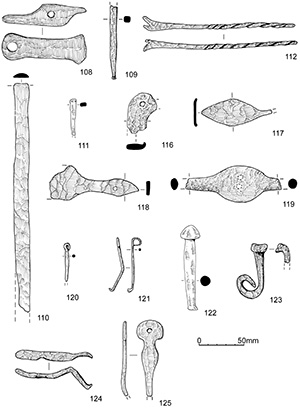
108. Bar, of almost constant width and variable thickness. It has one flat, rounded end, with a perforation, diam. 10mm. The centre of the bar is thicker, and has a circular hole at right-angles to the one in the end, diam. 6mm. The other end is flattened, and was broken in antiquity. It appears to be splaying out. Possibly post-Roman. L. 94mm, max. section 22x24mm. Machining layer 11000
109. Bar with a square section. One end tapers to a small, oval button tip, the other has a fresh break, and is probably starting to taper. It is possibly the end of an object such as the probable brazier or tripod leg from Ewell (Manning 1985a, 100 and pl. 45.P7), which has a small circular button on the end. L. 81mm, W. 8mm, tip diam. 5mm. Machining layer 12000
110. Bar with a D-shaped section, unperforated. It probably tapers at one end, but has flaked, and the other end may also be broken. The bar was found set across the top of a shallow hearth, apparently in situ, with the ends held in place with lumps of clay. It was presumably a firebar, or part of a grate. L 510mm, W. 34mm, Th. 16mm. SF7012, Context 14493, Hearth construction 14491, Group 703, Area L, Period 3
111. Bar fragment, tapering, narrower end broken. Looks like a sprig with a rectangular section, the head very slightly burred. This is possibly a very small punch, although it looks rather delicate for such a use. L. 40mm, max. section 7x4mm. SF7508, Cleaning layer 20184, Area L, not phased
112. Bar fragment, both ends broken in antiquity. One end has two projections, probably a broken and distorted loop rather than prongs, but rather faint on the X-ray. The bar tapers slightly, and the other end is twisted for c. 100mm. It is possibly part of an object such as a pan handle (cf. Manning 1985a, P34), a small flesh-hook or a small fire tool. L. 171mm. SF8413, Fill 23172, Pit 23214, Group 3047, Area N, Period 3
113. Not illustrated. Bar, with a slightly irregular, variable section, mainly oval. Both ends are broken. At one end a sliver of metal has been split off and bent upwards to form a small curved prong, which is complete. This was the method used to form the prongs of flesh hooks, but this is unlikely to be part of a flesh hook, as the bar is very crudely finished, and the prong too short. It may simply be working waste. L. 82mm, section c. 9x7mm, L. of prong 19mm. Layer 5386, Group 455, Area J, Period 6
114. Not illustrated. Bar, with a D-shaped section and one squared end. The other end is flattened into a thin plate in the same plane, the edges of which have some old and some new breaks, and whose original shape is uncertain. It probably splayed out symmetrically at an angle of c. 45°. This might be part of a spatulate blade such as Manning S134, though any identification must be very tentative. SF3356, which is a slightly tapering bar fragment with a similar section, is probably part of the same object, giving a handle length of at least 275mm. Bar L. 134mm, section 13x4mm. Blade surviving L. 52mm, max. surviving W. 52mm. SF3357, Fill 5864, Pit 5805, Group 444, Area J, Period 6
115. Not illustrated. Tapering bar, broken at the narrower end. The other end was flattened, and formed into a loop. This is probably the handle from an object such as a key or latchlifter. L. 63mm, section 15x10mm-8x6mm. Loop diam. 15mm. Fill 5864, Pit 5805, Area J, Period 6
116. Flat plate, curved, with a broken flange along the inside of the curve. Both ends are also probably broken. There is one perforation, in the middle of the curve, diam. 5mm. Variable W. 21-26mm, L. 52mm. SF6216, from the same context, is almost identical. If it were not for the flange, these pieces could be seen as curved terminals from strap hinges, as Manning R8. SF5921, Fill 15150, Pit 15231, Group 699, Area M, Period 5
117. Leaf-shaped plate with a short projection at one end, and probably with another broken off at the other end in antiquity. It is possibly a large (unused?) cleat. It is similar (apart from being flat rather than curved) to Manning S131, an arched plate with short projections at either end, from Hod Hill, possibly mid-1st century, which Manning suggests may have a specialised function. L. 79mm, max. W. 31mm. SF5456, Fill 14206, Pit 14207, Group 36, Area L, Period 2
118. Shaped plate fragment. It comprises a short strip, with a perforated spear-shaped terminal, with a nail through it (nail not illustrated). The other end flares out, but is broken. Possibly part of a drop hinge, as Manning R9, although somewhat smaller. L. 94mm, W. of terminal 20mm, W. of strip 12mm, max. W. 36mm. SF1830, Unknown context 5385, Area J, not phased.
119. Oval plate, probably with two perforations in the middle, tapering to a thicker bar at either end, both broken. The section of one bar is possibly rectangular, the other round. L. 115mm, max. W. 37mm. SF1829, Machining layer 7000, Area G
120. Rod, one end broken in antiquity. The other end is neatly looped. The small size of the loop suggests that this is not a buckle tongue or brooch pin. L. 45mm, diam. 4mm, loop W. 7mm. Layer 4014, Group 740, Area K, Period 4
121. Rod, with a square section. One end is looped, the other broken in antiquity, probably across the start of a bifurcation. This delicate piece is now bent, but this is unlikely to be the original shape. L. 65mm, section 2x2mm. Fill 9894, Well 9421, Group 772, Area D, Period 3B.
122. Circular-sectioned rod, probably complete, with a knob head, with a slight constriction immediately below it. The other end is slightly flattened. It appears to taper slightly, but this is probably the result of corrosion. Possibly a bolt or possibly a linch pin. L. 95mm, head diam. 21mm. SF7662, Cleaning layer 23001, Area N, not phased
123. Tapering strip, with the narrow end coiled round in the same plane. The other end was broken in antiquity, and is bent. Possibly part of a fitting. L. 60mm, max. W. 15mm. SF4739, Layer 13419, Group 634, Area I, Period 2-6
124. Strip, with an irregular curve. It has a curved notch out of one side, 10mm across, very similar to the notch on SF5120 (13360). One end is bent at right-angles, and tapers to a point, slightly upturned. The other end is broken. Were it not for the notch, this could be seen as just a distorted carpenter's dog. Possibly part of a lock. L. 64mm, W. 10mm, L. of arm 36mm. SF5525, Fill 14093, Pit 14099, Group 4019, Area K, Period 4-5
125. Terminal from an object, or strapping. It comprises a lenticular strip narrowing into a rectangular-sectioned rod at one end. The other end has an oval terminal, with a central hole. L. 85mm, max. W. 29mm, hole diam. 4mm. SF8308, Fill 15308, Pit 15309, Group 239, Area M, Period 2B
126. Not illustrated. Lump, in four pieces, containing four objects, lying parallel to each other. The objects present are i) a strip, tapering slightly, with a fresh break at the narrower end. The other end is looped. This is possibly a looped hinge, although there is no indication of perforations. L. 83mm, max. W. 22mm. ii) a rod with a circular section, probably slightly variable in diameter. One end has a fresh break, the other has the tip turned up. L. 74mm, diam. c. 8mm. iii) two bars with square sections. Both have a fresh break at one end, and blunt points at the other. L. 295mm and 230mm, section 10x10mm. SF1472, Fill 10035, Pit 10034, Group 789, Area E, Period 3
127. Not illustrated. A delicate strip, now distorted. It may have had a flattened terminal, and could be a casket fitting, although there are no perforations present. 44x4mm. SF1160, Fill 4129, Pit 4128, Group 744, Area K, Period 6
128. Not illustrated. Six fragments of a strip, probably all the same object, but with modern damage. Variable rectangular section, 24x6mm to 18x2mm, with at least one circular perforation toward the narrower end. Original L. >210mm. Hole diam. 6mm. SF7291, Fill 5841, Pit 5805, Group 444, Period 6
129. Not illustrated. Strap terminal, perforated. One end is slightly rounded, the other broken in antiquity. There are two other strip fragments from the context that may be part of this object, but do not join. 59x19mm, hole diam. 10mm. SF4375 Pit 5805, Fill 5841, Pit 5805, Group 444, Period 6
130. Not illustrated. Tapering strip, bent into a fairly tight curve, with the narrower end bent at right-angles. The other end was broken in antiquity. It somewhat resembles a spokeshave, but the taper is inconsistent with this interpretation. The wider end has a ragged break, suggesting that the object was forcibly broken, and this could be a distorted staple. Many of the Late Iron Age staple-like bindings and clamps from Danebury have tops of variable width (Cunliffe and Poole 1991, 353 and fig. 7.24). L. 62mm, W. 9-19mm. SF6914, Fill 13558, Pit 13560, Group 175, Area J, Period 2B
131. Not illustrated. Ring, 50%. This was presumably penannular or coiled, as one end comes to a blunt point. The other end was broken in antiquity. The section is slightly rounded. This was possibly a bracelet, as it is relatively slender for its diameter. External diam. 47mm, section W. 4mm. Layer 4689, Group 4019, Area K, Period 4-5
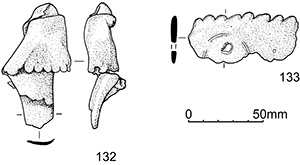
132. A fragment of very crumpled lead sheet with a scalloped edge. The function of this decoratively edged sheeting remains uncertain but Evans (2000b, 421-2) suggests that the fragment of lead sheet from a 3rd to mid-4th-century feature in Caerleon could be the decorative edging to a box covering or binding. SF931, machining layer 4000
133. Fragment of sheet with a scalloped edge. SF6306, Fill 8802, Pit 8801, Group 678, Area P, Period 6
134. Not illustrated. The site produced twenty lead balls, probably shot or musket balls. All but one were found in unstratified contexts. It is possible that the remaining one, which is from a Period 5-6 ditch [10538] in Area F, is intrusive. It had a diameter of 16mm.
The term 'rubber' has been used for pieces with surfaces smoothed by indeterminate wear; this could be use as a rubbing stone, or as a knife-sharpening stone, or as a crude mortar, for example. Nine rubbers were identified, none of them illustrated. Five were natural sandstone or sarsen pebbles, of which only one, from a prehistoric context, seems to have been shaped in any way prior to use. The other four rubbers were reused fragments of Millstone Grit querns. A complete list may be found in the archive catalogue.
There were a number of block and slab fragments, in a variety of stone types, and of uncertain use. Some of the slab fragments may be mixing palettes for cosmetics or medicines, but none have the bevelled edge typical of such objects. Some pieces appear too thick for palettes, and must have had other uses. Where noted, stone identifications are by Dr G.K. Lott of the British Geological Survey (GKL).
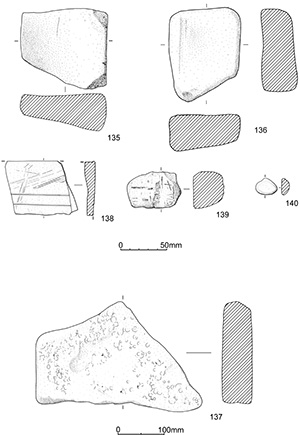
135. Pink Millstone Grit. Probably originally a quern, but reshaped as a rectangular palette or rubber. Both surfaces and one edge are smooth. The profile is wedge-shaped. W. 90mm, surviving L. 85mm, max. Th. 40mm, min Th. 19mm. Wt 432g. Fill 10296, Ditch 10406, Group 838, Area F, Period 5-6
136. Fine-grained, soft, yellow sandstone. A slabby, squarish fragment, probably utilised, and possibly from a quern. One face has two possible grooves. c 95x80mm, Th. 13-41mm. Wt 466g. Layer 10800, Group 8007, Area N, not phased
137. Slab fragment, one possible fairly straight original edge. The top is smooth, with slight damage (or possible deliberate carving?), and very faint striations on the surface. The underside is slightly irregular. Th. 30mm. c 175x110mm. Identification (GKL): Purbeck marble. Wt 1005g. Fill 16230, Ditch 16231, Group 584, Area H, Period 6
138. Fine-grained stone; possibly siltstone (not identified). A slabby fragment with a well-smoothed surface, back spalled. The face has two straight incised lines parallel to the edge, and there are also faint striations, parallel to each other, but at an angle to the incised lines. These scratches are ancient, and may be traces of tooling. c. 58x60mm, max. surviving Th. 14mm. Wt 70g. Fill 5135, Pit 5093, Group 433, Area J, Period 4
139. Chalk lump c. 56x40x30mm. There is possibly a pattern of incised lines on one flat face, although this may be a natural formation. Wt 98g. Fill 5964, Pit 13873, Group 445, Area J, Period 6
140. Well-polished, irregularly rounded, ?pebble. Translucent pale violet with a purple streak. Identification (GKL): Purple amethyst/quartz ?pebble. It is difficult to assign a specific source for this sample. Amethyst is a common component of mineral veins around the UK and mainland Europe. The sample may even have come from the local glacial drift. Wt 5g. SF6480, Fill 18352, Pit 18357, Group 641, Area I, Period 4
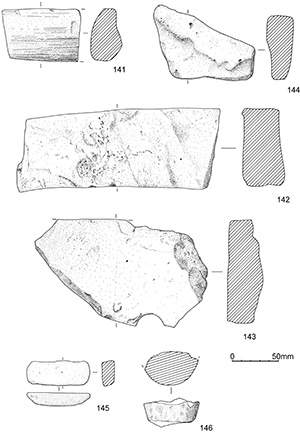
141. Fragment, possibly worked. It resembles a rim from a vessel, but may just be a natural stone broken along the bedding planes, as the edge would be rather straight for a vessel. The identification suggests that it may be a non-local stone, though it could be an erratic. Identification (GKL): Schist, probably from Scotland. Wt 252g. Layer 15982, Group 4024, Area M, Period 4
142. Tufa? A roughly rectangular slab, deliberately shaped, but with no other signs of use. Faces natural, sides more freshly broken. c. 205x83x47mm. Wt 1475g. Fill 24315, Post-hole 24314, Group 1212, Area M, not phased
143. Tufa? It appears to be a possible quern fragment with a central hole, but this is probably just an effect of the way that it has broken. It has one straight edge. One surface is roughly flat, the other irregular. Max. Th. 34mm. c. 190x120mm. Wt 635g. Fill 24315, Post-hole 24314, Group 1212, Area M, not phased
144. Crystalline shelly limestone? A slabby fragment, possibly with deliberate carving (although this may just be the effect of erosion). c. 230x130mm, Max. Th. 43mm. Wt 2140g. 20089, Oven construction 20137, Group 721, Area L, Period 6
145. Pebble fragment, probably not utilised, though possibly used as a whetstone. Wt 28g. SF7852, Fill 23427, Post-hole 23428, Group 1257, Area N, not phased
146. Crystalline sandstone. A roughly semi-circular slice, with the curved surface pecked. Possibly part of an architectural element, but could be a fragment from, for example, a pestle. Wt 82g. Cleaning layer 13316, Area I, not phased
147. Not illustrated. Fine-grained grey-green stone with thin bedding planes. Fragment from the corner of a slab. The surfaces are eroded, but the original thickness was probably c. 24mm. 114x53mm. Wt 222g. Cleaning layer 5597, Area I, not phased. Identification (GKL): Siltstone, probably Kimmeridge Clay Formation
148. Not illustrated. Piece of chalk with most of the surface surviving. It appears to have been crudely shaped, with possible cut marks visible. It is irregular, and does not appear to be a representational piece, so is presumably just a piece of building stone. c. 68x75x50mm. Wt 266g. Fill 10877, Pit 10910, Group 676, Area N, Period 5
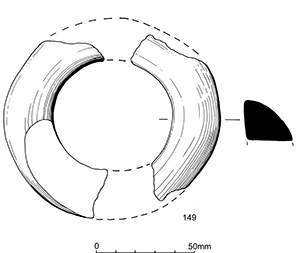
149. A plain annular object, damaged. Probably originally D-shaped in section, with the flat surface facing inward. External diam. c. 110mm. SF2649, Machining layer 11000, Area A, unstratified
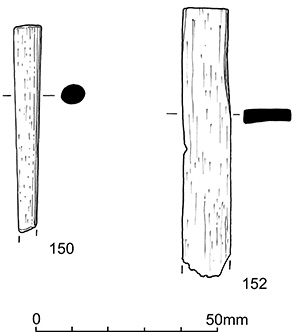
150. A ?peg with a flat head, elliptical section and a well-finished tapering shaft. Incomplete. Possibly an awl or a skewer? (see Crummy1983, 162). SF8157, unstratified 3999
151. Not illustrated. A roughed-out irregular quadrilateral, sawn into shape. L. 25mm. SF6825, 4142, Pit 4141, Group 1147, Area K, not phased
152. ?Inlay. A fragment of a parallel-sided strip, rectangular in section, possibly intended for use as inlay. Incomplete. Context 14558 SF6234, Fill 14558, Well 14529, Group 722, Area L, Period 6
153. Not illustrated. A section of antler tine roughly cut to an asymmetric point at the tip. Complete. SF7458, 4142, Pit 4141, Group 1147, Area K, not phased
Cite this as: Tyrrell, R. 2015, Baked clay, in M. Atkinson and S.J. Preston Heybridge: A Late Iron Age and Roman Settlement, Excavations at Elms Farm 1993-5, Internet Archaeology 40. http://dx.doi.org/10.11141/ia.40.1.tyrrell1
The Elms Farm excavations uncovered fifty-three fragments, weighing 12.1kg, of curiously shaped clay blocks of uncertain function, and ten other ceramic objects. These were identified during the classification of the loomweight assemblage and fall into the same fabric divisions, although the differences between the fabrics were not well defined.
The baked clay objects were examined macroscopically and divided into four fabrics (Fabrics F to I), according to the frequency and nature of the inclusions. Fabrics A to E were used in the classification of the daub. The same series with the exception of I was used for the loomweight classification. All of these fabrics were poorly or unevenly fired and have a variety of surface finishes. Some of the objects have been very roughly moulded, with uneven surfaces, while others are knife-trimmed or wiped smooth.
Fabric F: A poorly mixed fabric with sand, irregular fragments of quartz and flint pebbles. The colour is brown through to reddish at the core. There were nine fragments of Fabric F blocks, weighing 3428g.
Fabric G: This fabric had very little tempering, a small amount of sand and vegetable matter. The clay was evenly brown in colour, darkening slightly at the core. There were forty fragments of blocks in Fabric G, weighing 8112g.
Fabric H: A similar fabric to F but with smaller inclusions and some vegetable tempering. The surface has dense vegetable impressions. There was one Fabric H fragment and this weighed 68g.
Fabric I: A fabric with some evenly sorted sand and vegetable temper, dark orange-red in colour. There were fragments of three Fabric I objects, weighing 513g.
The identification of these has been problematic. The forty-one examples of this type of object were generally fragmentary and, with one exception, poorly fired, making it difficult to be sure of their exact shape and size. They are hand-made, occasionally knife-trimmed, and have right-angled corners. Some of the corner pieces have one edge rounded. The objects range in thickness from 15mm to 62mm, which suggests that they may be 'Belgic Bricks' similar to those found in pre-conquest and 1st-century AD contexts at Baldock, Herts. Rigby and Foster (1986, 188) suggest that these could have been used in building construction, or as floor slabs, or in ovens and kilns. They feel that the lack of any bonding material does not particularly support these uses, but it is possible the bonding eroded away during burial. Foster (1986b, 168), as part of her discussion of the loomweights, adds the possibility that the clay bars might also be weights.
Only one of the Elms Farm block fragments shows any sign of serious heat damage, so kiln use seems unlikely, though they could have had a domestic function. None of the Elms Farm examples were found near kilns or hearths, although they may have been redeposited. A group of baked clay slabs found at Stansted, Essex (Major 2004b, 173) were thought to have formed the ornamental edge to a hearth, but these had pronounced flanges not present on the Elms Farm examples. Most of the objects were deposited in pits with domestic rubbish. Contexts in Area L produced 56% of the blocks but again these are mostly from rubbish pits, which does not help clarify their use.
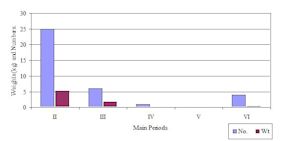
Most of the blocks were deposited in pits with pottery dating from mid-1st century BC to mid-2nd century AD (Figure 579). The increase in quantities in the late 4th century is misleading, as these are all small fragments from one ditch section, and may be redeposited.

154. A block/slab corner. The slight curve may be an accidental distortion. Fabric G. SF8507, Fill 19108, Pit 19104, Group 47, Area P, Period 2
155. A knife-trimmed corner of a block. Fabric G. SF8497, Fill 20260, Pit 20258, Group 91, Area L, Period 2B
There were twelve other objects made from baked clay. Several of these are thick rectangular and tapered blocks similar to kiln and oven furniture, although they are not particularly highly fired. They are similar in shape to the 'bricks' found in an early to mid-2nd-century kiln at West Stow, Suffolk (West 1990, 93-5), where they are thought to be kiln furniture. Only one example (no. 160) was found in a hearth, (15365), with the rest coming from rubbish deposits. A tapered block from the fill of pit 9218 (no. 158) was similar to one found in Rochford Road, Chelmsford. Wickenden (1992, 87-8) suggests the possibility of their use as pottery firedogs or a massive form of firebar. The earliest of these objects were found with pottery dating them to the 1st century BC. The latest context in which one of these was found is dated, by the pot, to between the mid-1st century AD and early 2nd century.
There is also a fragment of an object with a sub-rectangular section and a flat base from a pit in Area N (no. 162). Two similar objects were found at Slough House Farm, Essex (Major 1988c, 163, nos 12 and 13) but their use is also unknown.
Two possible parallels have been found for a drum-shaped object (no. 164) which came from a Period 2 slot in Area J. The possible heat-damage to the central depression initially suggested that it might have been used in a metallurgical process. It was examined by C. Mortimer during the assessment of the metalworking debris, but she concluded that it did not appear to have been heated to a high enough temperature, and that there was no evidence to connect it with metalworking. A fragment from a possibly similar baked clay object, from a late 2nd to early 3rd century context in the villa at Keston, Kent (Philp et al 1991, 153-4, fig 43, 21), is described as a container, although the author states that its function is unknown. Philp cites another broadly similar object that was found in a 1st-century AD ditch at Brockworth, Gloucestershire (Rawes 1981, 71), but this fragment is from a rectangular 'tray' rather than a rounded shape.
The functions of the freely moulded objects (nos 157 and 161) are even more difficult to identify and how these functioned remains unclear. They may simply be accidentally fired clay 'doodles'.

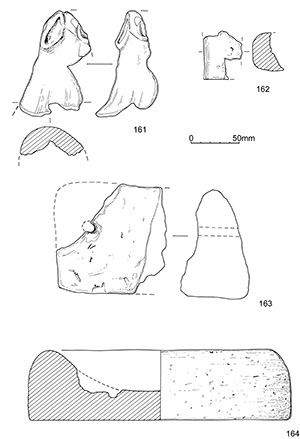
Figures 580, 581 and 582
156. Part of a lop-sided, roughly finished, bar-shaped object, with a rectangular base tapering to a saddled top. Fabric F. SF8432, Layer 4993, Group 750, Area K, Period 2
157. A roughly pinched, handle-like fragment. Fabric F. SF8489, 5214, Pit 5209, Group 442, Area J, Period 6
158. A bar with a truncated triangular section. Fabric F. SF8405, Fill 9370, Pit 9218, Group 768, Area D, Period 3A
159. A slightly curved bar. Fabric F. SF8491, Fill 11139, Pit 10910, Group 676, Area N, Period 5
160. The well-moulded, squared end of a bar, possibly from a kiln. Fabric G. SF8462, 15364, Hearth 15365, Group 2056, Area M, Period 2-3
161. A roughly moulded sub-conical object with applied thumbed additions at the tip. Fabric F. SF8404, 20196, Pit 20195, Group 88, Area L, Period 2B
162. A roughly finished cylindrical object with a flat base. Fabric G. SF8456, 23322, Pit 23391, Group 681, Area N, Period 3
163. Part of a bar-shaped object, with a rectangular base tapering towards the top and pierced through one end of the object. Fabric G. SF8463, Fill 15787, Pit 15757, Group 900, Area M, Period 3
164. A well finished, drum-shaped object with a depression in one surface. The centre of the depression seems to show greater evidence of heat damage than the rest of the object. Almost complete, but in fragments. Fabric I. Fill 13446, Slot 13447 Group 172, Area J, Period 2B-3
Cite this as: Goodburn, D. 2015, Wooden objects, in M. Atkinson and S.J. Preston Heybridge: A Late Iron Age and Roman Settlement, Excavations at Elms Farm 1993-5, Internet Archaeology 40. http://dx.doi.org/10.11141/ia.40.1.goodburn
None of the objects are very easily recognisable and the functional interpretations offered here could be debated. Comparative sources for Roman-period wooden finds have been consulted (Weeks and Rhodes 1986; Padley 1991; Earwood 1993; Cool and Philo 1998; Morris 2000) without finding close parallels except possibly for the suggested fence pale top (below). All dimensions given are post-conservation. It should be born in mind that Roman-period turnery finds are comparatively rare apart from small cylindrical boxes, which were not found here.
Unfortunately, the wooden objects were accidentally frozen and disintegrated on thawing prior to any illustration taking place.
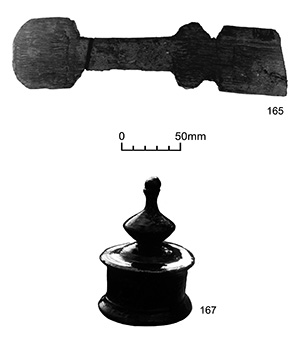
165. A wooden sword-like object (Figure 583). Originally complete, but now in six fragments. Made of radially cleft oak, split from a parent tree of fairly slow straight growth with c. 2mm wide annual rings. It was carved to the form of a small bat or blunt sword. The surfaces of the object are slightly worn and weathered, but the wear is not generally localised, although the blunt tip appears slightly battered. The maximum width of the blade is 60mm with a thickness of 11mm. The centre of the blade is roughly flat with tapering bevels down towards each blunt edge in the manner of a sword. The handle is approximately 115mm in length with a crudely axe or adze carved pommel. The space between the pommel and blade of the sword is uncomfortably narrow for a man's hand and might be more suited to the hand of a child or woman. The function of the object is not absolutely clear, but three possibilities seem most likely, that it was a toy sword, a paddle-like bat for pottery or dairy work, or that it was a weaving sword. SF2758, 8196, Well 8188, Group 788, Area E, Period 4
166. A finely turned object. Complete when lifted, now in two fragments totalling c.125mm long with a diameter of approximately 30mm. The cross-section is now slightly oval but it is uncertain whether this represents ancient drying from a green turned state or post-excavation shrinkage. The object has a smoothly turned original end c. 25mm in length, which is convenient for the thumb to grip. A lathe centre mark and faint saw marks can be seen on that end.
The other 100mm of the surviving length of the object was carefully and regularly turned to produce a series of concentric beads c. 3mm wide and 3mm proud. A small hole c. 4mm in diameter had been drilled through the thickness of the object where the bead turning stopped. The object appears only slightly abraded, but is full of ancient woodworm holes. The borer damage suggests that it may have lain abandoned in an unheated, probably damp room for sometime or that the wood is sapwood, as the heart wood of walnut has some resistance to beetle attack in normal domestic conditions. It is not clear what part of the parent log has been used for this object although it is clearly not a section of roundwood.
The wood used for this object has been identified as walnut which seems visually plausible. It has been suggested that the timber was probably of south-east European origin. This is quite possible but recent detailed pollen studies have suggested that walnut was almost certainly introduced to Britain during the Roman period as an orchard tree along with many other useful plants and trees (Scaife 2000, 116). Therefore the object could have been made in Britain, possibly quite locally. The function of the object is obscure but its size and form suggest an origin in a small piece of domestic equipment of some sort. SF5667, 16083, Well 6280, Group 531, Area H, Period 4
167. A turned 'finial' or pendant (Figure 583). Complete when lifted, now in three pieces. It appears to have been roughly sawn off the end of a larger turned object, perhaps to enable the bulk of that object to be reused in some way. The maximum diameter of the object is 80mm and the maximum surviving length c. 95mm, the last 30mm of that being a small loose projecting bobble that must have almost reached the end of the original artefact. The main solid cylinder of the object is pierced by three evenly spaced, bored and chiselled holes c. 10mm square. In two cases the holes contain shrunken wood fragments and in the other the convex-ended hole could be seen to be c. 25mm deep. The chisel used was clearly 8mm wide. The object was turned from a piece of roundwood rather than a split section of timber, and the species has been identified as birch, which seems plausible visually.
The function of the turned object is not at all clear and its form cannot be paralleled in the noted corpora. However, observations of a modern (mock ancient) suspended light fitting in turned wood with three evenly spaced mock bronze arms supporting light bulbs has thrown up an interesting possible origin for this offcut. The modern fitting had a turned cylindrical core ending in a very similar finial or pendant to this object although it was c. 10% smaller. As we know that lamps were often suspended in Roman Britain, perhaps this object could be interpreted as the end of such a decorative light fitting that originally had three light radiating wooden arms to support three lamps slung on light metal chains. No obvious use for this object in furniture or another common application seems plausible. Images of Roman interiors shown in wall paintings at Pompeii (dell Orto and Varone 1992) and elsewhere have been scanned but have not yet revealed a representation of such a light fitting so this identification is offered very tentatively. SF6615, 9879, Well 9421, Group 772, Area D, Period 3
168. A crude roundwood 'handle'? This crudely worked section of bark-less roundwood has a roughly knife cut, tang-like projection at one end, suggesting either that it was a rough handle for a tool of some kind or that it had been joined into some sort of frame. Both ends had been neatly rounded with a knife and are slightly worn. The total length is 255mm and the maximum diameter c. 20mm. The species of the roundwood has not been identified. SF7185, 16083, Well 6280, Group 531, Area H, Period 4
169. A probable spear-shaped fence pale top. This blade-like section of roughly carved oak sapwood has the form of a spear-head broken both at the tip and the tang. The total surviving length is c. 135mm, width 105mm and the maximum thickness c. 16mm. This object seems to have been fairly carefully axe or adze carved to a form very close to that found in three examples of Roman period fence pales with spear-shaped terminals that have been found in the London area (Goodburn forthcoming). The top of any well requires fencing or protecting in some way to stop it being a danger to animals and people and prevent material falling in it and fouling the water. In Britain there is quite good evidence of fencing in wells and waterholes from at least the Bronze Age and often this appears to have been done with oak pales (see Masefield et al. 2003).
This fragmentary example is somewhat unusual as it appears to have been made from a thin outer slab from a hewn beam or saw baulk, as it has faint saw marks on the heart wood side and a hewn surface on the other. Such sawn slabs are widely used today for cheap, short life fencing that can last up to c. 15 years if well off the ground. The other examples from London were made of cleft oak heart wood for durability and strength in thin sections. The parent log from which this fragment was cut derived from an oak of fairly slow growth as the fragment had c. 10 annual rings. SF7603, 8196, Well 8188, Group 788, Area E, Period 4.
Internet Archaeology is an open access journal based in the Department of Archaeology, University of York. Except where otherwise noted, content from this work may be used under the terms of the Creative Commons Attribution 3.0 (CC BY) Unported licence, which permits unrestricted use, distribution, and reproduction in any medium, provided that attribution to the author(s), the title of the work, the Internet Archaeology journal and the relevant URL/DOI are given.
Terms and Conditions | Legal Statements | Privacy Policy | Cookies Policy | Citing Internet Archaeology
Internet Archaeology content is preserved for the long term with the Archaeology Data Service. Help sustain and support open access publication by donating to our Open Access Archaeology Fund.